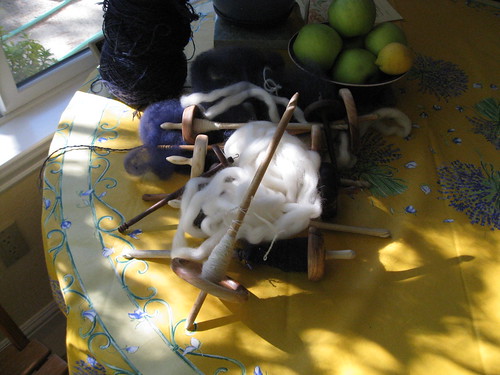Back in art school, I learned that: Art is something that makes people think about their world. In general, art is a non-functional representation of an object, i.e., paintings, sculpture, textile art, jewelry, decorations on objects (color patterns in functional textiles), and public architecture. In the “Art World” functionality has no value. Decoration is everything.
And then we had “crafts”, which were functional objects. We were pushed to find the perfect tea pot, the perfect wine chalice and so forth. If we were going to make a perfect tea pot, we had to learn how to make tea. We had to test our tea pot(s) to ensure that they were perfectly functional. In the craft world, decoration without function is nothing.
I think that most hand knitting over the last 80 years falls into the category of: “Art”. Consider the fisherman's sweater.
Long ago, a fisherman's sweater displayed his social status, but mostly it kept him warm. Warmth was the core function of such a sweater. A representation of the sweater that did not function to keep the wearer warm was, and is “art”. This would include a textile representation that does not provide the warmth of the original sweater. Worsted weight yarn knit on # 6 needles will never come close to providing that kind of warmth, and thus is “art”. Modern hand knit sweaters are decorative – they are knit on big needles, and the wind blows right through them taking body heat with it. If you want a real fisherman's sweater, knit it on #1 needles.
A lot of knitters shout that, “Oh, my lace shawls are so warm!” or “my hand knit socks are completely functional.” Statements that one's woolen objects are “warm” are disingenuous, because the really remarkable thing about this knitting is how little warmth these objects do provide for the amount of wool used to construct them. Yes, lace shawls are light weight and provide detectable warmth and protection from drafts, but their primary purpose is as objects of personal adornment. They are badges that wearer does not have to work (and stay) outside when the weather turns foul. Originally they were worn as badges of a Shetland woman's great skill in domestic chores. A lace shawl showed that she could could do her chores and still have time to spin and knit decorative items for herself. Then, ladies form the south started buying such shawls to show the wearer's family was rich enough to afford a heated environment. If you are wearing a lace shawl as your primary outer garment and you have to stay outside in a cold rain squall, you are going to get wet and cold. In contrast, the Shetland women wore warm clothing under their lace shawls. Shawls are a display of status display rather than for practical warmth. Lace shawls are “warm” only in a culture that thinks that a “fisherman's sweater” knit on US 6 needles from [4] weight yarn is warm.
Hand knitters recite the myth that “any hand-knit wool is warm”, (but that if you go out side, you have to put a jacket on to stay warm.) By commenting on how warm their hand knit objects are, these knitters are saying, “My art is to produce a little warmth from a lot of wool!” In early Victorian times, that was indeed very clever art. It took the concept of “warm wool” and stood it on its head. It made people think. Now, that clever art has become the norm, and warm, hand-knit wool has become the rarity.
Most modern hand knit socks are not durable enough to be particularly functional – in truth, they are no more functional than a painting of socks. (Do not tell me how long your socks last. Consider the the fresco on the wall.) Those socks function as personal adornment, as a statement that I can waste my time knitting non-functional objects. The knitter says, “My hand knit socks are more functional than the store bought socks.” Ok, but are the store bought socks functional?
I had a good bit of time in the big department stores over the weekend, and the socks that I saw therein were designed for personal adornment. Thus, saying that your hand knit sock is more functional than what you can buy at Needless Markup, is just not saying much. Those socks are primarily for personal adornment – jewelry made out of textiles. I look at the sock yarns that are being sold to knitters and the sock patterns that are popular, and together these produce more textile jewelery than functional socks. They are not people that walk much. These yarns and patterns produce socks that scream, I am well to do, I do not have to walk, I can drive or take a taxi. I mean they are buying sock yarns made from fine, short staples and they are knitting it loosely. Does the knitter really expect the resulting sock to be “durable”?
One more point, in those department stores, the cheap knit sweaters and hats had gauges similar to that of most modern hand knitting. However, the very expensive (machine knit) sweaters and hats had gauges and textures similar to what I knit. It was what I consider to be warm and durable. It seems that Needless Markup and its suppliers concur with me on what makes a good knit fabric.


.jpg)